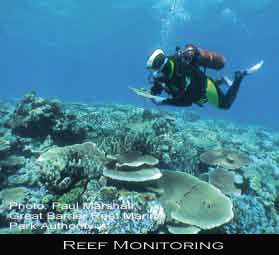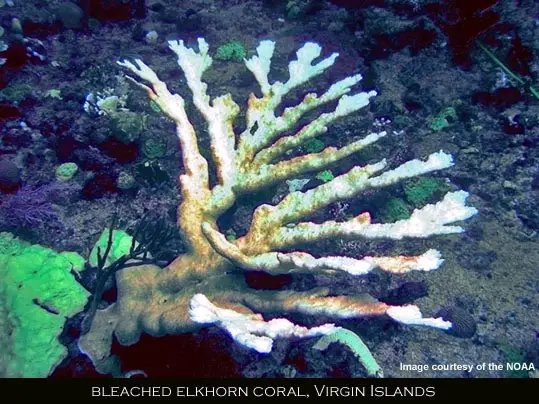Coral bleaching is a stress condition in reef corals that involves a breakdown of the symbiotic relationship between corals and algae (zooxanthellae). The algae provides food for the coral and also holds the colony together. The bleaching of the coral indicates the absence of the algae and signals trouble for the reef. Without the algae, the coral will not reproduce and will eventually die.
The symptoms of bleaching include a gradual loss of colour as zooxanthellae are expelled from the coral tissue, sometimes leaving corals bone white. This loss exposes the white calcium carbonate skeletons of the coral colony. Corals naturally lose less than 0.1% of their zooxanthellae during processes of regulation and replacement. However, adverse changes in a coral’s environment can cause an increase in the number of zooxanthellae lost. There are a number of stresses or environmental changes that may cause bleaching including disease, excess shade, increased levels of ultraviolet radiation, sedimentation, pollution, salinity changes, and increased temperatures.
Bleaching stress is also exhibited by other reef animals that have a symbiotic relationship with zooxanthellae such as soft corals, giant clams, some sponges, etc.  Sea Temperature Monitoring
Sea Temperature Monitoring
Elevated sea temperature is thought to be a major stress to reefs, causing widespread coral bleaching. The most extensive and intensive coral bleaching events on record occurred in 1998 and 2002. This phenomenon is now the subject of an international research and monitoring effort.
Along the Great Barrier Reef of Australia, data are obtained from in-situ data loggers deployed on the reef. Data loggers instantaneously record sea temperatures every 30 minutes and are downloaded every 6 to 12 months, depending on the site. Loggers are double- or triple- calibrated against a certified reference thermometer after each deployment and are generally accurate to ± 0.2°C. Temperature loggers on the reef-flat are generally placed at or near Lowest Astronomical Tide level. ‘Reef-slope’ (or where specified as ‘Upper reef-slope’) generally refers to depths 5 m to 9 m and ‘deep reef-slope’ refers to depths of around 20 m. Monitoring provides the information basis for assessments of the status of coral reefs, and ultimately for management and conservation decisions.

Coral Bleaching Events
In 1998 coral reefs around the world experienced the most extensive and severe bleaching in recorded history. Coral bleaching was reported in 60 countries and island nations at sites in the Pacific Ocean, Indian Ocean, Red Sea, Persian Gulf, Mediterranean and Caribbean. Indian Ocean corals were particularly severely impacted, with greater than 70 percent mortality reported in the Maldives, Andamans, Lakshadweep Islands, and in Seychelles Marine Park System.
Unlike most previous bleaching events in which severe impacts were limited to less than 15 m water depth the 1998 bleaching affected corals at up to 50 m water depth. This mass bleaching followed similar but less severe events in 1987 and 1990. Prior to the early to mid 1980s, bleaching tended to be rare and localized, and corals generally recovered.
The Future
The marine environment faces a long period, i.e. centuries, of water temperatures which are higher than present levels. The conditions that cause widespread coral bleaching globally were considered to happen once every few decades. It is predicted that the hot years where the tolerance limits of the corals are exceeded will be even hotter and more frequent.
Corals are already showing signs that they are approaching or exceeding their temperature tolerance limits, and in the eastern Pacific Ocean some local extinctions have been reported as a result of bleaching.
Protecting fish populations can aid reef recovery after a bleaching event, and scientists have showed that reefs can recover three times faster if fish populations are not depleted by overfishing. Overfishing in the Philippines, Guam, and Indonesia has caused the disappearance of many types of food fish (groupers, snappers, emperors) from entire areas. Without these predators in the area, the sea urchin population has increased. Sea urchins kill live coral as they feed on algae. Eventually, algae growth overtakes the coral, and new polyps cannot grow.
Coral reefs are extremely important for biodiversity, providing a home to over 25% of all marine life. They are also vital for people and business, sustaining tens of thousands of people. They provide nurseries for many species of commercially important fish, protection of coastal areas from storm waves, and are a significant attraction for the tourism industry. Recent studies have shown that coral reef goods and services provide an annual net benefit of US$30 billion to economies worldwide(Cesar et al, 2003). Global warming is likely to spell a death sentence for many coral reefs. If the present rate of destruction continues, most of the world’s coral reefs could be killed within our lifetime.
Recently, New Scientist reported that Coral reefs in the Indo-Pacific are disappearing twice as fast as tropical rainforests. These results came from the first comprehensive survey of coral reefs in this region, which is home to 75% of the world’s reefs. The report goes onto say that, in the early 1980s about 40% of reefs were covered with live coral, but that number had halved by 2003. Today only 2% of Indo-Pacific reefs have the same amount of live coral as they did in the 1980s.
References
Cesar, H, Burke, L and Pet-Soede, L. (2003) The economics of worldwide coral reef degradation, Cesar Environmental Economics Consulting: Arnhem (Netherlands), 23 pp.
Grimsditch, G.D, and Rodney V. (2006) Coral Reef Resilience and Resistance to Bleaching, The International Union for the Conservation of Nature and Natural Resources / The Nature Conservancy.
